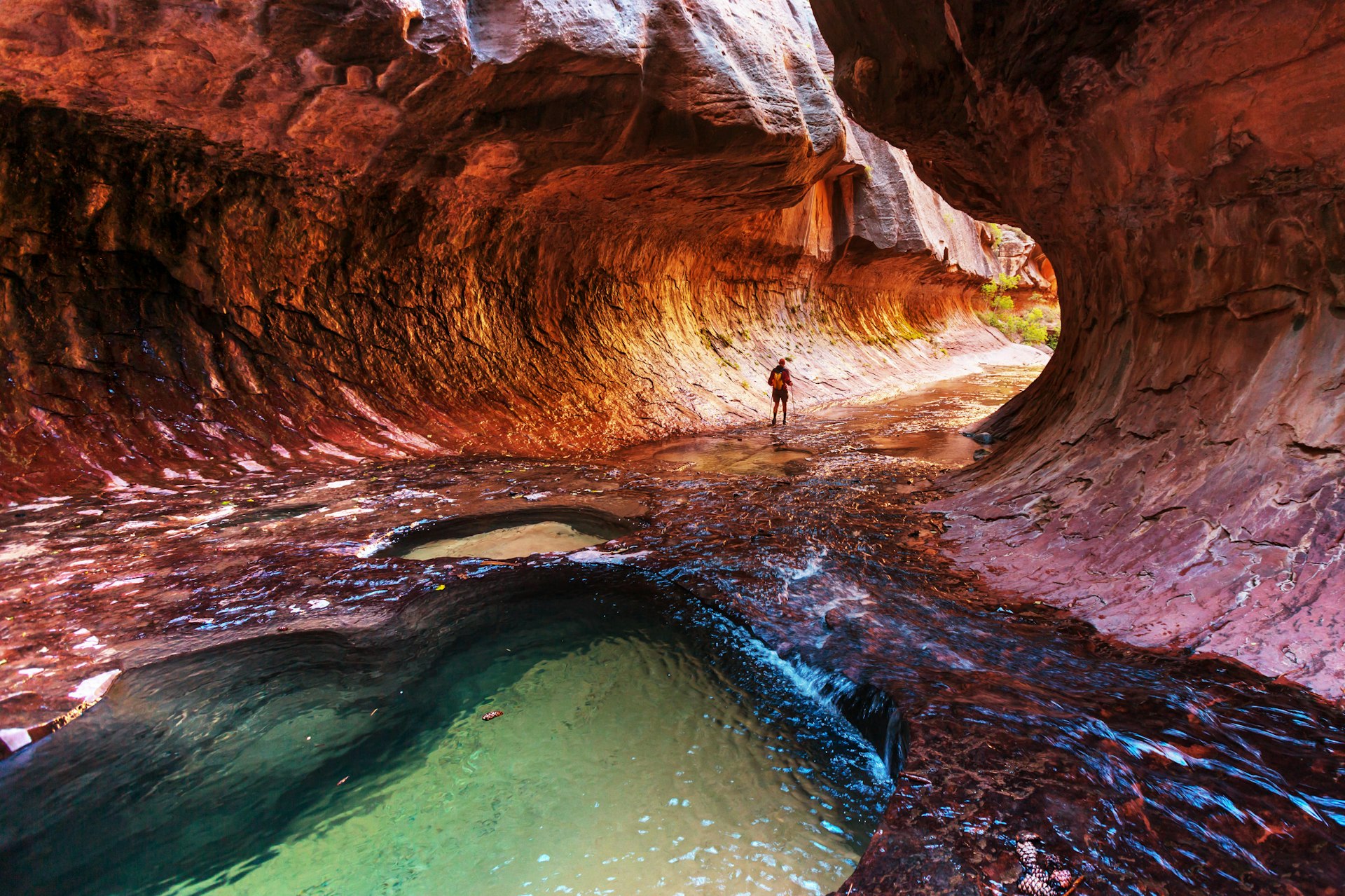Heavenly Zion National Park is the holy grail of Utah’s “Mighty 5” and one of the most-visited national parks in the country.
The towering red and white cliffs of Zion Canyon, one of Utah’s most dramatic natural wonders, loom high over the Virgin River, and are enshrined in the park’s original name, Mukuntuweap, the Native Paiute word meaning “straight canyon.” Mormon settlers who arrived here in the 19th century rechristened it Zion, an ancient Hebrew word meaning “sanctuary.”
It’s impossible not to be overcome by the awesomeness of Zion, and the names of its prominent features and rock formations reflect the early Anglo view that Zion is a place on a higher plane: Angels Landing, Court of the Patriarchs, Cathedral Mountain and the Temple of Sinawava, named for the Paiute coyote spirit.
Hiking through the Virgin River in the Narrows or gaping at the canyon from the top of Angels Landing after a 1500ft ascent is indeed amazing, but for all its might and majesty, Zion National Park also holds smaller and more delicate beauties: sandstone rocks “weeping” with water, tiny grottoes, hanging gardens and mesa-top wildflower meadows.
Zion’s beauty is no secret. Nearly five million people pass through its entrances every year, making it the third most-visited national park in the United States. Summers can sometimes feel claustrophobic, and more mandatory permits have been introduced to control the crowds. But quieter corners can still be found, and much of Zion’s 232 sq miles are little-visited backcountry.
If it’s your first time visiting Zion National Park, here’s a guide to what you need to know before you go.
When should I go to Zion National Park?
Zion is one of the most-visited national parks in the United States, and about half a million people pour through the park’s entrances every month between April and October. The best times to visit Zion National Park, spring and autumn, bring balmy temperatures and relief from sweaty summers and frosty winters, but these seasons also attract crowds looking to enjoy the park at its prime.
However, if you’re set on hiking the Narrows, spring and summer can be tricky times to visit. The springtime snowmelt that feeds the Virgin River can send water levels soaring, and when the flow of water is faster than 150 cubic feet per second, the National Park Service closes the hike. The Virgin River’s flow rate in spring is unpredictable: sometimes the Narrows will close in early March and not open until late June, and other years the hike will remain open all season. The National Park Service posts current closure notices and dates from previous years on its website.
In summer, flash flooding in the Narrows and other Utah slot canyons is a genuine threat, and hikers have died from being swept away in the rushing waters. The rain doesn’t necessarily have to fall in the park – a surge of stormwater can flow down the river even when the sun is shining overhead. Heed all warnings posted by the National Park Service before you set out on a hike.
Some of Zion’s most popular hikes and activities – including Angels Landing, the Subway and the top-down route of the Narrows – require permits that are issued by lottery, so when you visit might be dependent on when you can score a permit. Far fewer people apply for wintertime permits, though these hikes, especially those in water, require extra care and equipment.
How much time should I spend at Zion National Park?
While you can zip through Zion Canyon in a day, you’d miss out on getting to the heart of this gorgeous national park. With limited time, hop on the Zion Canyon Shuttle from the Visitor Center and set off on the shorter hikes that give a taste of Zion’s unique landscape. Ride the shuttle bus to the last stop, Temple of Sinawava, and take the 2-mile round-trip Riverside Walk, a dry, paved route alongside the Virgin River. The paved trail ends where the Narrows begin, but if you’re short on time, resist the river and check out Zion’s other watery features: the delicate hanging gardens at Weeping Rock and the three Emerald Pools, where clusters of tiny, fragile plants cling to near-vertical rock walls, fed by water seeping out of the sandstone.
If you have more time, tackle Zion Canyon’s longer and more challenging hikes – Angels Landing (permit required) and the Narrows (additional gear often required) – and visit East Zion and Kolob Canyons.
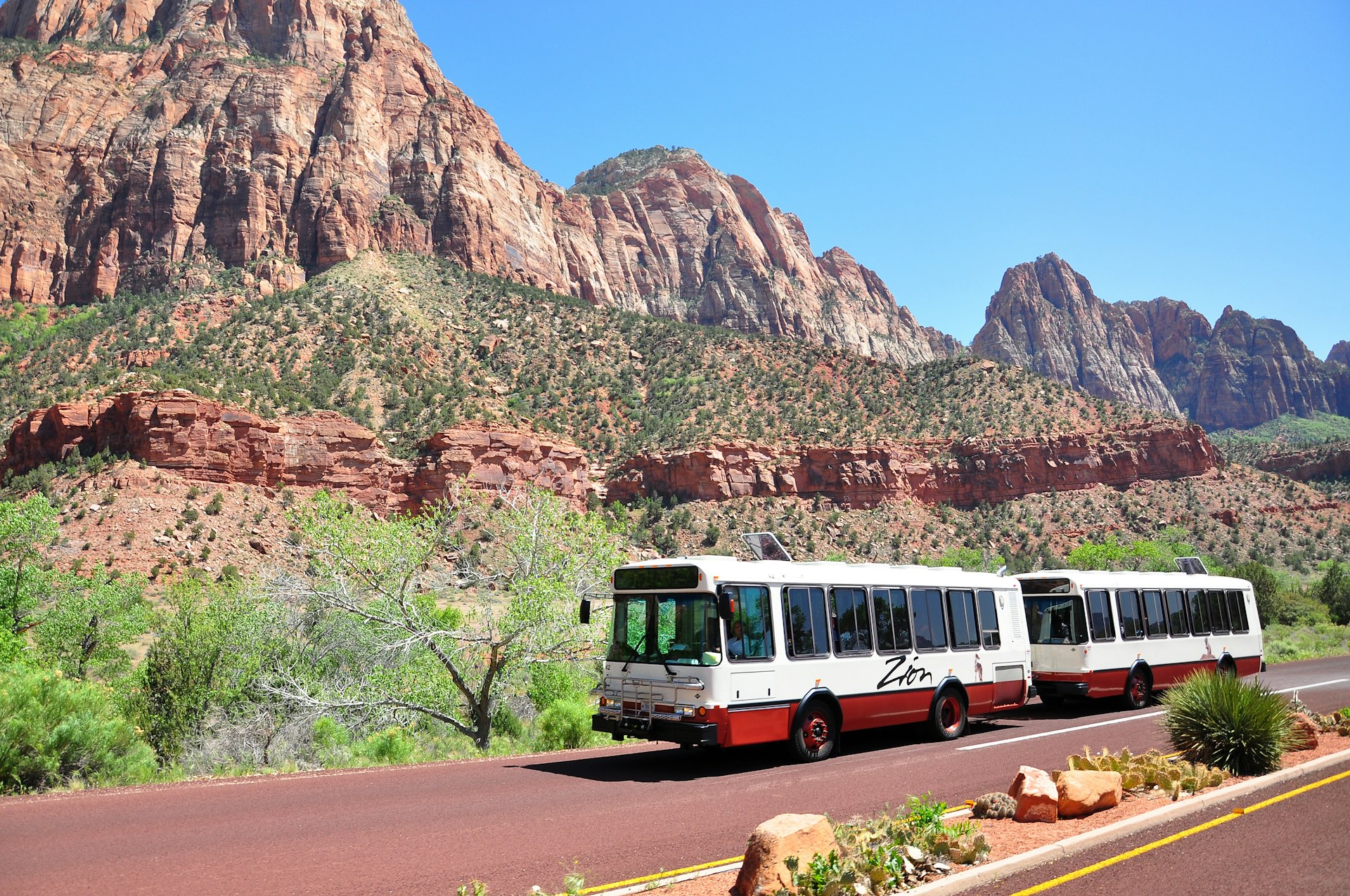
Is it easy to get to and around Zion National Park?
Yes, depending on your starting destination, it’s easy to get to Zion National Park, even without a car. The largest major airport closest to Zion is in Las Vegas, and shuttle bus companies can whisk you to the gateway town of Springdale in about three hours. (The closer Utah town of St George has a small airport with just a few direct flights.)
Getting around Zion Canyon without a car is also easy – and even required for much of the year. From March to the end of November, the National Park Service runs the free Zion Canyon Shuttle between the Zion Canyon Visitor Center and the Temple of Sinawava, the location of the trailheads for the Riverside Walk and the Narrows. Private vehicles are not allowed on Zion Canyon Scenic Drive, the road through the canyon, when these shuttle buses are operating.
If you’re staying in Springdale, a separate but also free shuttle bus stops along the town’s main street, where most of the hotels are located. The Springdale Line Shuttle ends a short walk from the Zion Canyon Visitor Center. Limited free parking is available inside the park; arrive as early as possible. Otherwise, it costs $20 to park in Springdale.
The main part of Zion National Park has two ways in: the south entrance near Springdale and the east entrance a short drive from Hwy 89. Near the national park’s east entrance, the historic 1.1-mile Zion–Mt Carmel Tunnel was once the longest tunnel in the country. It was completed in 1930 to the specifications for cars at that time (it’s just 22ft wide), so today’s RVs and other oversized vehicles are a tight squeeze. If your vehicle is wider than 7ft 10in or taller than 11ft 4in, you must pay $15 for a tunnel permit and drive through during specified hours when rangers are present so that the tunnel can be converted to one-way traffic.
You need a car to visit the lesser-seen areas of Zion National Park, including Kolob Canyons and Kolob Terrace Rd. These areas are not served by regular shuttle buses or other public transportation.
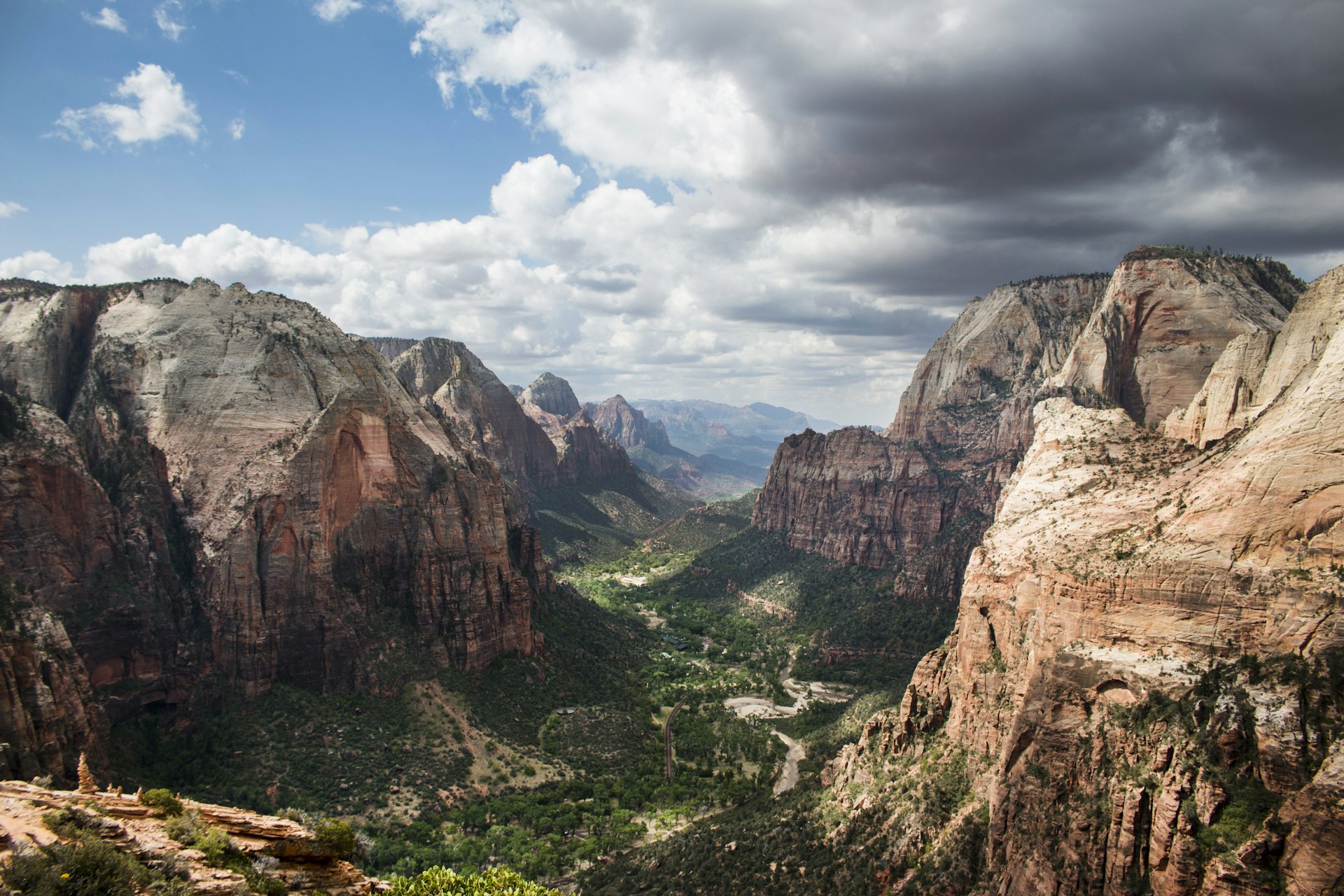
Top things to do at Zion National Park
The 5000ft of elevation change from Zion Canyon’s floor to the park’s highest peak provides an astounding range of environments. Even the park’s two main hikes – the Narrows and Angels Landing – are polar opposites: one wades through river water that churns through a slot canyon, and the other embarks on a chain-assisted white-knuckle climb to a narrow plateau so high that a minister visiting in the early 1900s quipped that “only angels could land there.”
Angels Landing permits are required to hike the final stretch – the famous part where hikers pull themselves up by chains to reach the overlook with sheer drops and 360-degree views – but you can go as far as Scout Lookout without a permit. For our money, if you’re already putting in the work to conquer Walter’s Wiggles, a series of 21 steep switchbacks on the hike up, you might as well reward your athletic efforts with the full experience and get the Angels Landing permit.
The three Emerald Pools (Lower, Middle and Upper) and Weeping Rock offer gentler trails to oasis-like hanging gardens where plants cling to dripping seeps on the canyon walls. Note: at the time of writing, Weeping Rock was inaccessible due to rockfall. Check online for the latest information before heading out.
Zion Canyon certainly hogs the spotlight, but it’s not the only part of the national park. In East Zion, Observation Point stands 700ft above Angels Landing, but it feels like cheating to reach the viewpoint along the flat woodland path, gloriously skipping the sweaty haul up Walter’s Wiggles. Observation Point was previously accessible from Zion Canyon via the East Rim Trail, but this route has been closed since 2019 because of a landslide and has yet to reopen.
The area around Zion’s east entrance has several more trailheads, and another excellent hiking option is Cable Mountain. At the end of the hike and at the edge of the canyon, the remnants of the historic Cable Mountain Draw Works are a reminder of the ingenuity and resourcefulness of the people who have called this place home. The contraption was once used to lower lumber 2000ft from the East Rim mesa to the floor of Zion Canyon, reducing the timber’s transport time from weeklong trips by wagon to just two minutes. Hundreds of thousands of board feet were sent into the valley, including the lumber used to build the original Zion Lodge.
You can also escape the Zion Canyon crowds by checking out the trailheads along Kolob Terrace Rd and in the Kolob Canyons section of Zion National Park. These areas aren’t connected to Zion Canyon by road, but they are on overnight backpacking trails. Kolob Canyons is actually just off Interstate 15 but doesn’t see nearly as many visitors as Zion Canyon.
Need more inspiration? Here are the best hiking trails in Zion National Park
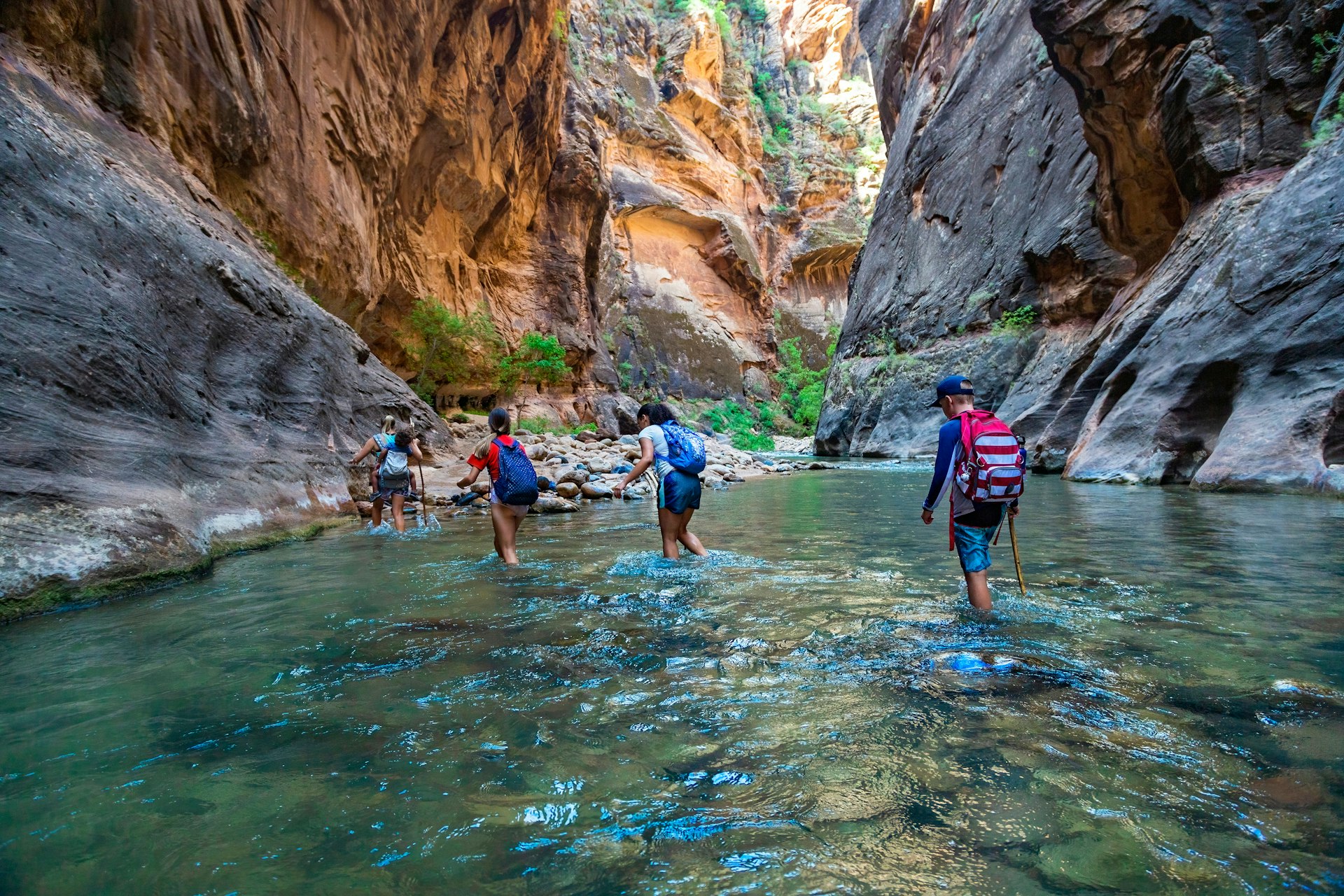
My favorite thing to do at Zion National Park
My hiking boots and I have spent a lot of quality time together. We’ve trekked all over the world, but I can easily say that wading through the Narrows at Zion National Park is one of my favorite hikes on the planet. The Narrows is quintessential Zion, and this wet and wild “trail” is actually the Virgin River itself. Nothing brings out the kid in me like splashing in the river, and the sense of awe is infectious as you hike through the flowing water, wondering what’s around every river bend.
Hordes of hikers visit the Narrows, but many don’t walk more than a mile or two. Quieter sections await the further you go. The best part about hiking the Narrows is that you can walk for as little or as long as you’d like and still have a great time.
As an almost entirely water-based hike, the Narrows isn’t your standard walk in the park. Outfitters in Springdale rent canyoneering shoes, neoprene socks, wooden walking sticks, and dry suits or bibs. You don’t necessarily have to get the gear, but what you wear in the Narrows will greatly influence your enjoyment of the hike. The Narrows is cooler than elsewhere in Zion because of the tall canyon walls, and hypothermia can be a risk in colder months. A walking stick helps you navigate the fast-moving currents on slippery rocks, and you’ll want to put your phone, camera and anything else you don’t want to get wet in a dry bag.
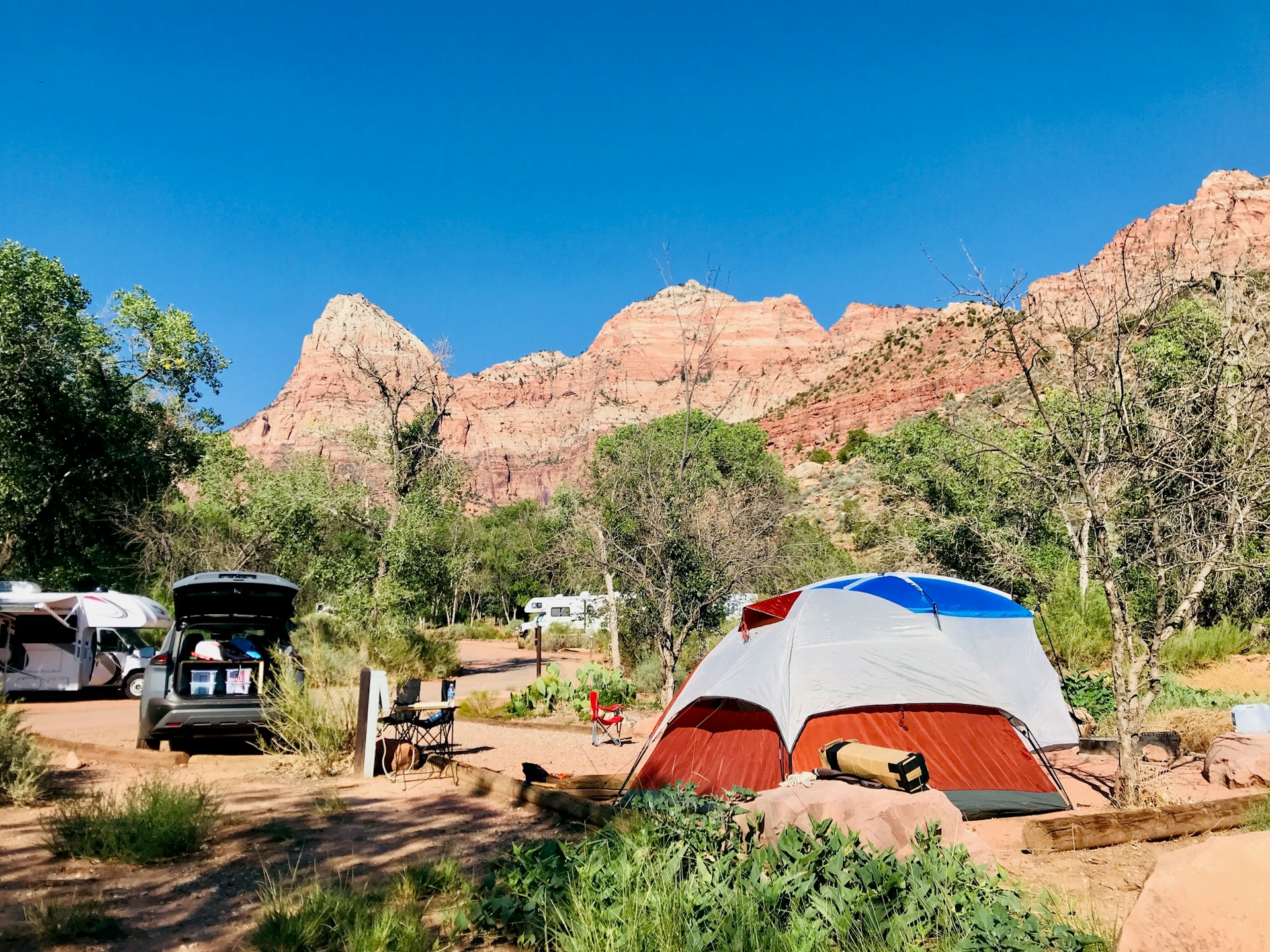
How much money do I need for Zion National Park?
The standard entrance pass for Zion National Park costs $35 per vehicle or $20 per person if you’re visiting on foot, and it’s valid for seven days. If you’re visiting more national parks on a road trip through Utah and beyond, it’s worth buying the America the Beautiful pass for $80. The America the Beautiful pass is valid for a year at all national parks and federal recreation land across the country for one vehicle or four per person entry fees – arguably one of the best travel deals available.
Accommodations in and around Zion National Park can be pricey. Zion Lodge costs $200 to $350 per night depending on the season and the room size, and rooms can be booked out months in advance. Tent-only campsites at Watchman Campground cost $35 a night, and sites with electrical hookups cost $45 per night.
Tent-only campsites at Lava Point Campground off Kolob Terrace Rd are cheaper ($25 a night) but are open seasonally (usually May through September). These sites are primitive, with pit toilets and no running water. You can camp for free on Bureau of Land Management (BLM) land in Utah, but these areas have no facilities.
What is the closest city to Zion National Park?
The town of Springdale sits at Zion National Park’s south entrance, and it’s so close that you can treat yourself to a post-hike beer at Zion Canyon Brew Pub just after leaving the park boundary. Springdale is a small town but is filled with excellent, if pricey, accommodation options, as well as lots of restaurants, cafes and grocery stores. Find cheaper accommodation options in the towns of Virgin, La Verkin and Hurricane (pronounced “hur-uh-kin”) west of Zion along Hwy 9.
Where’s the best place to stay near Zion National Park?
Zion is one of Utah’s two national parks that has noncamping accommodations inside the park, at the historic Zion Lodge, opened in 1924 but rebuilt after a devastating fire in 1966. (Nearby Bryce Canyon National Park also has a lodge.) Reservations here and at Zion Canyon’s two campgrounds (Watchman Campground and South Campground, currently closed for long-term renovations) can be made up to six months in advance.
Springdale has a wealth of accommodations, though the proximity to the south entrance means higher prices. Not far from Zion’s east entrance, Zion Ponderosa Ranch Resort is a good pick for families, with tons of on-site activities, including a climbing wall, swimming pool, mini golf and paintball. You can even glamp in a Conestoga wagon.
Zion Ponderosa is also a good base camp for travelers looking to tackle the hikes in East Zion. Its sister company East Zion Adventures runs shuttles to the trailheads for Observation Point and Cable Mountain, and it’s best to go with it because the roads are extremely rutted and parking is minimal.
